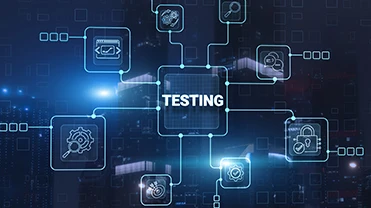Scaling IoT Testing: The hidden key to
innovation at scale
Innovation in IoT goes beyond connectivity — it’s testing at scale that keeps it alive.
Every new protocol, firmware update, or hardware variant multiplies the complexity of testing. Devices speak in multiple “languages” — BLE, Zigbee, Wi-Fi, MQTT, Matter, and countless proprietary ones — leaving testers juggling platforms, firmware updates, hardware quirks, and cloud integrations. What works beautifully in a lab often breaks when scaled across thousands of devices in the real world.
And here’s the real kicker: with over 40.6 billion IoT devices expected to join the existing IoT device ecosystem by 2034, scalable testing is no longer optional; it’s business critical.
What makes testing truly scalable?
The bridge between lab success and field-scale reliability is a scalable test automation framework.
Think of it as the engine that powers validation: running scripts, managing data, tracking results, and connecting the dots. It helps IoT companies test smarter, not just harder, delivering:
- Consistent validation across devices and ecosystems
- Faster turnaround on firmware and software updates
- Confidence that products won’t collapse at scale
The IoT testing framework: Layers that must be validated
IoT solutions are a combination of hardware and software, and each has unique challenges. While QA strategies differ across products, every IoT solution can be broken down into distinct layers that must be validated both individually and as an ecosystem.
- Device & Sensor Layer: Ensures accurate, secure data collection with functional and security testing.
- Network & Gateway Layer: Validates seamless connectivity across Wi-Fi, BLE, Zigbee, Matter, and more.
- Service Quality Layer: Checks that IoT services meet performance, compatibility, and API expectations.
- Application Layer: Ensures the user experience is intuitive, reliable, and localized.
A scalable test automation framework holistically validates these layers while working seamlessly across both standard and proprietary protocols.
Building blocks of a scalable IoT test automation framework
A strong framework isn’t just about automation; it’s about designing for scale. Key elements include:
- Modular & Protocol-agnostic Architecture: Reusable drivers, APIs, and simulators ensure tests run seamlessly across various protocols without rewrites.
- Hardware-in-the-Loop (HIL) & Simulation: Blending real and virtual devices captures real-world edge cases.
- CI/CD Integration & Test Orchestration: Automated pipelines validate every update from the start, cutting risks early.
- Data-Driven Testing & Analytics: Logs and insights highlight regressions, performance issues, and bottlenecks.
- Cloud & Mobile Integration for Scalability: Ensures device-to-cloud-to-app workflows scale reliably in real-world conditions.
From theory to practice: How to implement
While the framework’s design principles define what needs to be in place, successful adoption requires a step-by-step implementation strategy:
- Select the Right Toolchain: Choose automation tools that support multi-protocol IoT testing, such as Robot Framework or custom Python-based frameworks.
- Build Reusable Abstractions: Implement device abstraction layers and modular drivers so test scripts can be reused across hardware variants and protocols.
- Leverage HIL & Simulation at Scale: Deploy a mix of physical devices and virtual simulators in your test environment to reproduce rare scenarios, validate resilience, and accelerate parallel testing without inflating costs.
- Automate via CI/CD Pipelines: Set up pipelines that trigger regression, security, and performance tests automatically with every new firmware or software build, ensuring continuous validation without slowing down release cycles.
- Implement Monitoring and Reporting: Centralise logs and use dashboards to monitor test results, trends, and system health over time.
Softdel’s strategic role
At Softdel, testing is not just a validation step — it’s a strategic enabler of IoT adoption at scale. By blending deep protocol expertise, future-ready IoT labs, and automation-first practices, we help customers accelerate device readiness with confidence. Here’s how we make it happen:
- Protocol Expertise at Scale: From Matter and BACnet to Zigbee, BLE, and proprietary stacks, our protocol libraries and test suites validate interoperability across diverse ecosystems.
- Softdel IoT Labs: Our IoT Labs replicate complex field conditions by combining real and virtual devices. With integrated HIL environments, we validate product performance, safety, and reliability far beyond what virtual-only simulations can achieve — covering the full spectrum of testing from hardware to ecosystems, AI/ML readiness, cybersecurity, and compliance, ensuring today’s products and tomorrow’s ecosystems are ready for the real world. Take a tour of Softdel IoT Labs.
- CI/CD-Ready Testing: Our expertise in embedding automated test suites into CI/CD pipelines ensures every build is validated early and consistently.
- Accelerators: Our proven offerings like softTAF (a modular test automation framework that cuts effort and boosts reusability across devices and protocols) and BOSS (our industry-recognized BACnet Device Simulator that replicates thousands of devices at scale) empower customers to achieve faster, smarter, and more reliable test outcomes.
- Actionable Insights, not just Reports: Not just pass/fail — but clear recommendations that accelerate releases and improve product quality.
Softdel built a dedicated offshore interoperability test lab to validate BACnet, LON, and proprietary protocols, cutting regression testing time by 75% and accelerating time to market for a global leader of intelligent building solutions.
The IoT world is evolving at breakneck speed. Without scalable test automation, testing becomes the biggest bottleneck to innovation.
By embracing modularity, hardware-in-the-loop, protocol abstraction, and CI/CD readiness, companies can ensure their IoT products are field-ready — whether it’s a smart lock, an industrial sensor, or an EV charger.
At Softdel, we help IoT innovators future-proof their testing frameworks, so they can focus on what truly matters: bringing innovation to market faster, more reliably, and with confidence.
Ready to scale your IoT testing?







